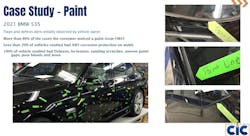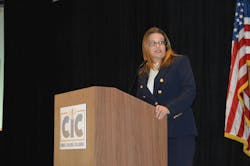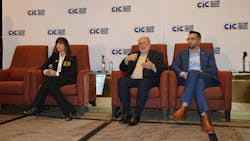If you spend any time on social media in collision repair discussions, you’ve probably seen the results of post-repair inspections uncovering sins by unscrupulous repairers: panel gaps one can see daylight through. Unaddressed weld burns or missing corrosion protection. Buckles remaining in frame rails. Some of the flaws are visible with the naked eye; some require some sleuthing with a borescope. But how serious are some of the flaws in these vehicles that prompted those inspections?
With much talk in the industry about substandard repairs and the post-repair inspections that uncover them, the Collision Industry Conference’s Industry Relations: OEM-Repairer Committee conducted a survey on them to gain some insight on the topic. Committee members revealed the results of that study at the Collision Industry Conference Jan. 17 in Palm Springs, California. What it found in an examination of 26 post-repair inspections was that 90% of those vehicles were deemed a total loss as a result of those inspections, and half of them had structural damage that had not been addressed.
“Anyone can have a bad day,” said Liz Stein, OEC national account manager. “But that poor repair experience can have multiple negative consequences, not only for the consumer, but for every other stakeholders in the business. So, we wanted to look at some case studies to be able to quantify how prevalent this is.”
Daniel Rosenberg, BASF OEM strategic account manager and who helped compile the study, said the vehicles are “classic examples of what’s going on in the industry when these examples come up.”
What the committee found was the post-repair inspections were typically prompted by the vehicle owner noticing fit and finish problems, said Ron Reichen, president of Precision Body & Paint, Beaverton, Oregon, who noted the data came from collision repair shops or companies that specialize in post-repair inspections.
“What is the first thing they see? Obviously, it's going to be inclusions in the paint, paint color match, and things of that nature, because that's what they see. They don't see underneath the onion, so to speak. And then that's what starts the process.”
Repairers following a blueprint, OEM repair procedures, and a defined process throughout the damage analysis can help provide accountability and a predictably favorable outcome, he advised.
“Once the consumer sees the paint flaws, that raises red flags. Maybe it's a panel adjustment: they opened the door and there's a creak because there’s a panel misalignment between where the fender intersect. But there's something that prompted that client to say, ‘I have concerns about this, I don't have confidence with the repair facility, so I'm taking it to another facility.”
The panel detailed multiple case studies showing vehicles not only missing advanced driver assistance systems (ADAS) calibrations (they weren’t listed on the final bill from the initial repair, so they were assumed not to have been done for free) but with structural damage significant enough to not only prevent an accurate ADAS calibration but that would cause poor handling and tire wear.
Erin Solis, Certified Collision Group vice president of OEM and industry relations, noted that during the investigations, she discovered one of the customers had gone back to the original shop nine times without a favorable end result.
“You have to be involved,” she said. “Whether it's from a manager standpoint, or a production manager standpoint, or from one department to the next, there must be accountability. And there must be other checks along the way to make sure that the process you put into place at your store is being followed.”
In the case of a Subaru post-repair inspection case study, she found there were no calibrations of the EyeSight camera or blind spot monitoring sensors. And there were no inspections of the seatbelts, airbags, steering column, or steering rack, as required by Subaru. Fewer than 30% of the vehicles studied had any post-repair calibration, she said.
Rosenberg shared a slide detailing the flaws found in a 2018 Honda CR-V. Although its initial estimate was $4,000, the post-repair estimate ballooned to $14,000.
It’s critical to keep in mind the human component, Stein said, that for most customers, a vehicle collision is a traumatic event.
“That customer who was back nine times, that means nine times that customer had to pause whatever was going on in their life to address something that wasn’t fixed. It creates frustration, it creates anger and resentment, and it creates a negative impression [about the build of the vehicle.]”
Shops must not only have the proper tools, equipment, facility, training, and access to OEM repair information, she advised, but to be sure when the shop’s only aluminum-qualified technician is on vacation, no one else is allowed to repair an aluminum vehicle, as an example.
“Have a quality-control process and make sure your people are empowered at any point in the process to be able to stop and say, ‘Hey wait a minute... this isn't right,’ that if you're a painter, and something comes to you that looks like a train wreck you can call a timeout and send it back to the technician and you’re not penalized for stopping the process.”
Stein noted the committee participants include representatives of General Motors, Hyundai and Genesis, Mazda, and Nissan, who have a stake in seeing their vehicles repaired properly.
“One of the things I wanted to talk about is how do we help talk about protecting the brand of the manufacturer,” she said. “When there's a collision repair event, that tests the manufacturer's brand. And when there's a poor repair experience, that could mean that the customer has a negative brand impression.”
Reichen said the committee would continue to dig deeper on the topic for another presentation.
“Where did those total-loss vehicles go? Were they crushed? Or did they end up back on the roads again? That's certainly problematic.”
About the Author
Jay Sicht
Editor-in-Chief, FenderBender and ABRN
Jay Sicht is editor-in-chief of FenderBender and ABRN. He has worked in the automotive aftermarket for more than 29 years, including in a number of sales and technical support roles in paint/parts distribution and service/repair. He has a bachelor's degree in journalism from the University of Central Missouri with a minor in aviation, and as a writer and editor, he has covered all segments of the automotive aftermarket for more than 20 of those years, including formerly serving as editor-in-chief of Motor Age and Aftermarket Business World. Connect with him on LinkedIn.
Don't miss Jay's next article or podcast. Sign up for FenderBender Today's Collision Repair News and ABRN eNews here.



